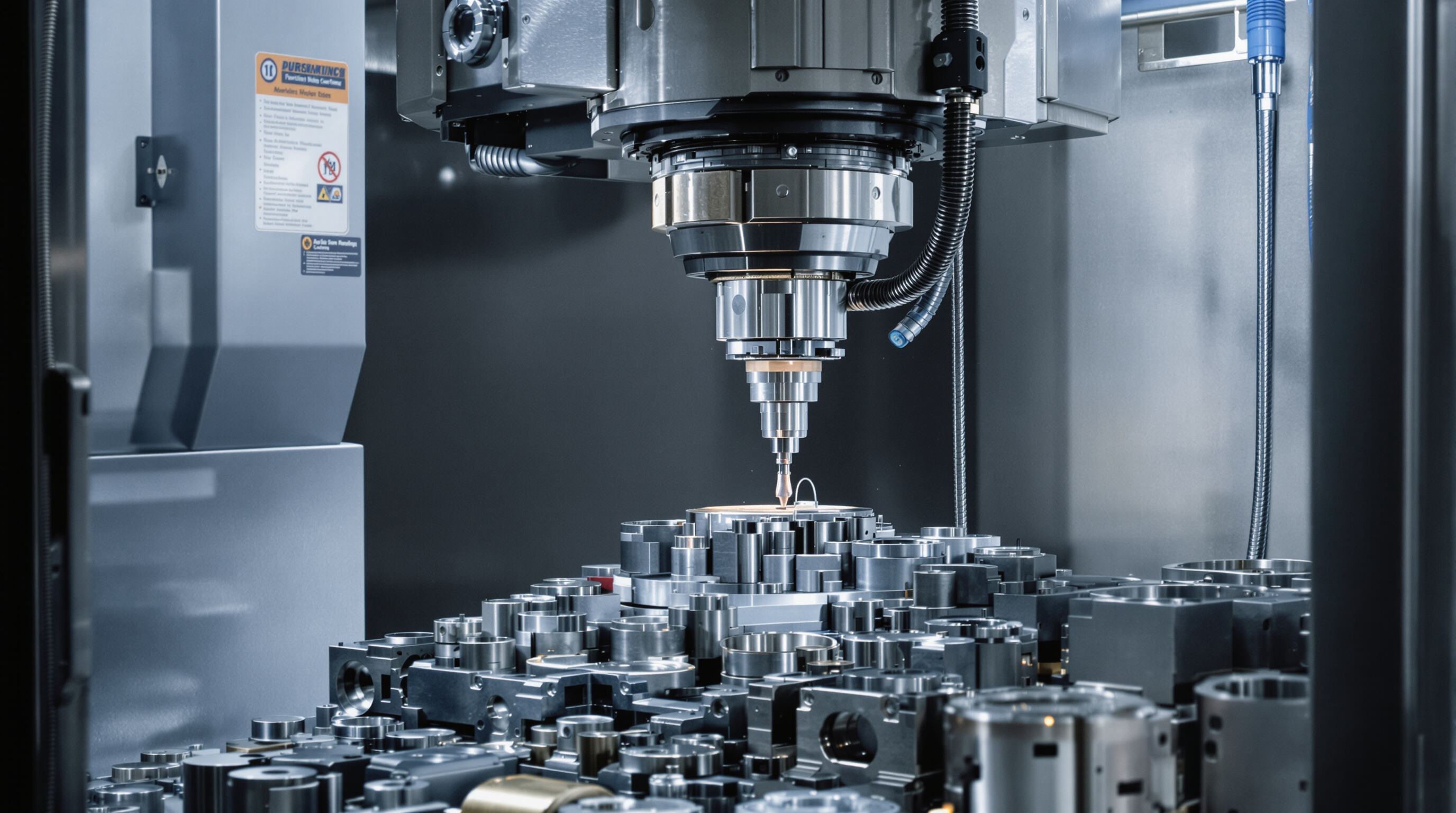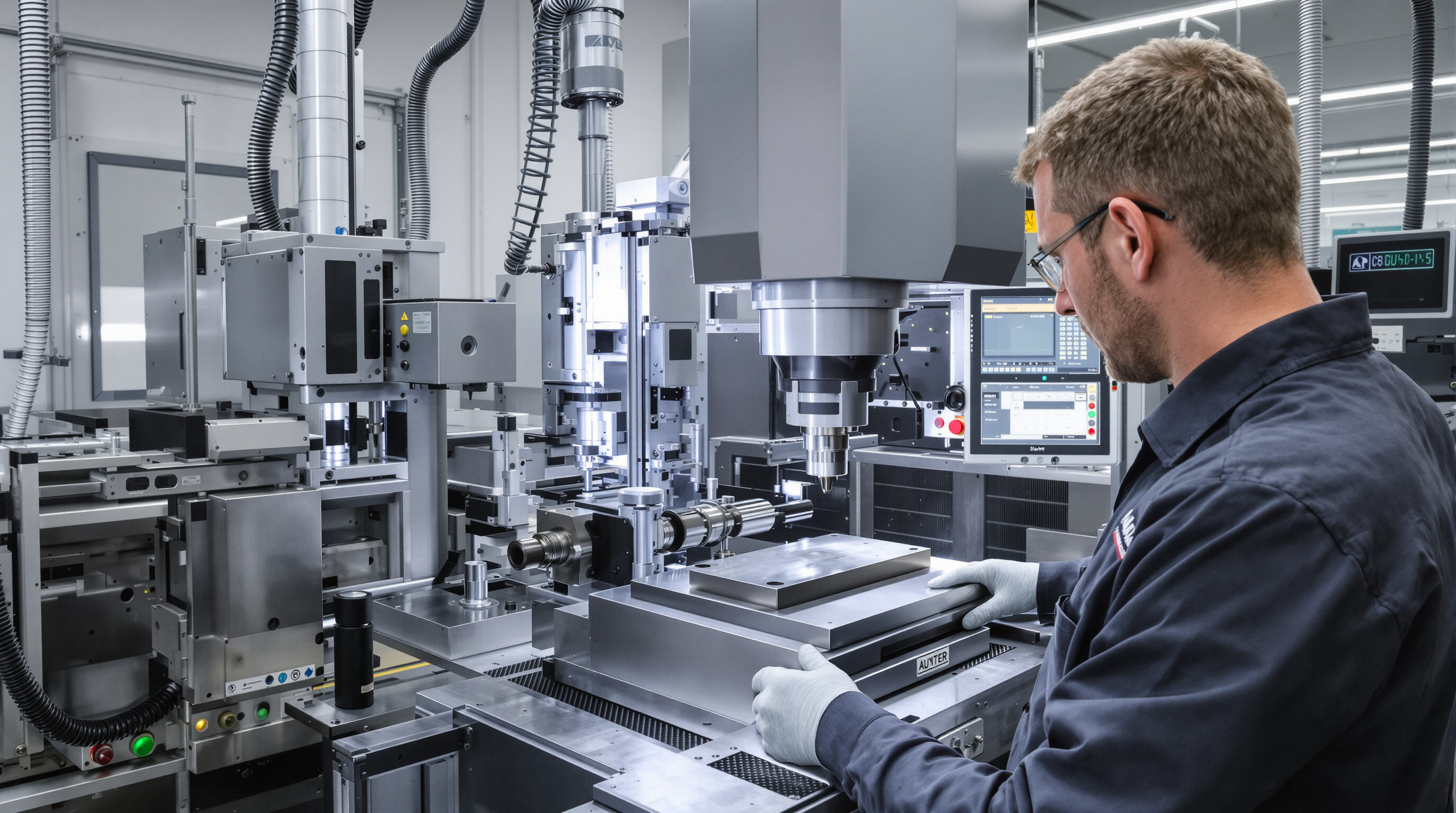การประเมิน การกลึงที่มีความแม่นยำ ความสามารถและอุปกรณ์

การเข้าใจศักยภาพของเครื่องจักร CNC สำหรับการผลิตที่มีความแม่นยำสูง
ร้านงานกลึงความแม่นยำสูงในปัจจุบันพึ่งพาอย่างหนักต่อระบบควบคุมเชิงตัวเลขด้วยคอมพิวเตอร์ (CNC) เพื่อให้ได้ค่าความคลาดเคลื่อนที่แน่นอนมากจนถึงระดับ ±0.0005 นิ้ว ซึ่งเป็นสิ่งจำเป็นอย่างยิ่งในอุตสาหกรรมต่างๆ เช่น อุตสาหกรรมการบินและอวกาศ รวมถึงการผลิตอุปกรณ์ทางการแพทย์ เมื่อพิจารณาถึงเทคโนโลยีการกลึงความเร็วสูง (HSM) เทคนิคเหล่านี้สามารถให้พื้นผิวหลังการกลึงมีความหยาบต่ำกว่า 1 ไมโครเมตร ซึ่งมีความสำคัญอย่างมากต่อชิ้นส่วน เช่น ใบพัดกังหัน ที่ประสิทธิภาพการทำงานขึ้นอยู่กับความเรียบเนียนของพื้นผิวเป็นหลัก จากการวิจัยล่าสุดในวารสาร International Journal of Advanced Manufacturing Technology ในปี 2023 พบว่าผู้ผลิตมีการลดลงของความแปรปรวนของขนาดชิ้นงานประมาณ 43% เมื่อใช้เครื่องจักร CNC เมื่อเทียบกับวิธีการดั้งเดิมในการผลิตข้อต่อสะโพกไทเทเนียม สิ่งนี้แสดงให้เห็นอย่างชัดเจนว่าระบบอัตโนมัติช่วยรักษาความสม่ำเสมอระหว่างล็อตการผลิตได้ดีเพียงใด โดยเฉพาะอย่างยิ่งเมื่อชีวิตของผู้ใช้งานขึ้นอยู่กับความน่าเชื่อถือของชิ้นส่วนโดยตรง
บทบาทของอุปกรณ์ขั้นสูง เช่น เครื่องกัดและเครื่องกลึง CNC แบบหลายแกน
เครื่องกัดซีเอ็นซีแบบห้าแกนเพิ่มความแม่นยำและความมีประสิทธิภาพในการผลิต เนื่องจากไม่จำเป็นต้องปรับตำแหน่งชิ้นงานด้วยมือ ใช้เวลาตั้งค่าลดลงประมาณ 70% เมื่อเทียบกับวิธีการแบบดั้งเดิม และยังคงความแม่นยำในการจัดตำแหน่งไว้ที่ประมาณ 5 ไมครอน สำหรับชิ้นส่วนที่ซับซ้อน เช่น หัวฉีดน้ำมันเชื้อเพลิง สิ่งนี้มีความสำคัญมาก เนื่องจากชิ้นส่วนเหล่านี้ต้องการความแม่นยำในการหมุนอยู่ในช่วง ±0.001 องศาขณะเจาะมุมต่างๆ โดยทั่วไป ระบบแบบสามแกนจำเป็นต้องตั้งค่าประมาณสามถึงสี่ครั้งเพื่อประมวลผลรูปทรงที่คล้ายกัน ซึ่งจริงๆ แล้วทำให้อัตราความผิดพลาดโดยรวมเพิ่มขึ้นประมาณ 22% ตามรายงานล่าสุดจาก NIST ในปี 2024 เมื่อผู้ผลิตนำเครื่องกลึงแบบหลายแกนมาใช้ร่วมในกระบวนการทำงาน จะสามารถผลิตชิ้นส่วนที่มีรายละเอียดสูงได้โดยใช้แรงงานคนน้อยลงมาก สิ่งนี้ไม่เพียงแต่ช่วยเพิ่มความสม่ำเสมอระหว่างล็อตผลิตภัณฑ์ แต่ยังช่วยเร่งรอบการผลิตได้อย่างมาก
กลยุทธ์การกลึงส่งผลต่อความแม่นยำ ความสามารถในการทำซ้ำ และความคลาดเคลื่อนที่แน่นหนาอย่างไร
เมื่อโปรแกรมการตัดถูกปรับให้เหมาะสมอย่างถูกต้อง จะช่วยลดคลื่นความถี่ของการสั่นสะเทือนที่รบกวนจิตใจได้ราว 31 เปอร์เซ็นต์ ซึ่งส่งผลให้พื้นผิวที่ได้มีความเรียบเนียนมากยิ่งขึ้น ในปัจจุบัน ระบบเครื่องจักรที่ปรับตัวได้ (adaptive machining) ส่วนใหญ่พึ่งพาเซ็นเซอร์ที่ให้ข้อมูลตอบกลับแบบเรียลไทม์ เพื่อให้ผู้ควบคุมสามารถปรับอัตราการให้อาหาร (feed rates) ตามความจำเป็นในระหว่างกระบวนการผลิตจริง ซึ่งช่วยให้ทุกอย่างอยู่ในช่วงความคลาดเคลื่อนที่กำหนดไว้แน่นอน โดยทั่วไปจะต่ำกว่า 10 ไมครอน แม้ในกรณีที่ผลิตชิ้นงานเป็นล็อตใหญ่กว่า 10,000 ชิ้น ผู้ผลิตเลนส์แสง (Optical lens) ได้รับประโยชน์อย่างมากจากความแม่นยำในการควบคุมเช่นนี้ ด้วยผลลัพธ์ที่สม่ำเสมอ ทำให้รูปทรงโค้งของเลนส์สามารถทำซ้ำได้ถึง 98 ครั้งจากทุกๆ 100 ครั้ง แล้วในทางปฏิบัตินั่นหมายถึงอะไร? หมายถึงการใช้เวลาน้อยลงในการขัดเงาหลังการกลึงที่ต้องทำอย่างระมัดระวัง โดยเฉลี่ยแล้ว ชิ้นส่วนแต่ละชิ้นสามารถประหยัดเวลาในการทำงานด้วยมือถึงประมาณ 18 ชั่วโมง และแน่นอน สิ่งนี้ก็แปลงไปสู่การประหยัดต้นทุนที่สำคัญในกระบวนการผลิตโดยรวม
การประเมินระบบควบคุมคุณภาพและใบรับรองอุตสาหกรรม

กระบวนการตรวจสอบหลัก: เครื่องวัดพิกัด (CMMs), การทดสอบพื้นผิว และการตรวจสอบแบบเรียลไทม์
การวัดมิติให้ถูกต้องมีความสำคัญอย่างมากเมื่อพูดถึงงานกลึงความแม่นยำ ร้านค้าส่วนใหญ่พึ่งพาเครื่องวัดพิกัด (Coordinate Measuring Machines) หรือที่เรียกสั้นๆ ว่า CMMs ซึ่งสามารถตรวจสอบรูปร่างที่ซับซ้อนได้ละเอียดถึงประมาณบวกหรือลบ 0.005 มิลลิเมตร เครื่องวัดความหยาบของพื้นผิว (Surface profilometers) ก็มีบทบาทสำคัญเช่นกัน โดยใช้วัดความเรียบเนียนของชิ้นงาน บางครั้งสามารถตรวจจับความหยาบได้ละเอียดถึง 0.4 ไมโครเมตร โรงงานผลิตที่ทันสมัยบางแห่งในปัจจุบันยังมีระบบตรวจสอบการสึกหรอของเครื่องมือและติดตามการเปลี่ยนแปลงของอุณหภูมิขณะเครื่องจักรกำลังทำงานอยู่ ตามรายงานอุตสาหกรรมจาก Ponemon ในปี 2023 ระบุว่า การตรวจสอบแบบเรียลไทม์นี้สามารถลดวัสดุที่เสียไปได้ประมาณ 18 เปอร์เซ็นต์ เมื่อเทียบกับการตรวจสอบชิ้นงานหลังการผลิตแบบ manual เพียงอย่างเดียว สรุปให้เข้าใจง่ายๆ คือ ชิ้นงานที่ถูกปฏิเสธจะลดลง ซึ่งหมายถึงประสิทธิภาพที่ดีขึ้นโดยรวม และความหงุดหงิดที่ลดลงสำหรับทุกฝ่ายที่เกี่ยวข้องในกระบวนการผลิต
ความสำคัญของระบบคุณภาพ ISO 9001, AS9100 และระบบ MRP/ERP แบบบูรณาการ
การรับรองคุณภาพ เช่น ISO 9001 และ AS9100 แสดงให้เห็นถึงความมุ่งมั่นของผู้จัดส่งในการสร้างระบบการจัดการคุณภาพที่แข็งแกร่ง ผู้ผลิตที่ได้รับการรับรอง ISO 9001 มักจะผลิตชิ้นส่วนที่มีข้อบกพร่องลดลงประมาณ 34% ในอุตสาหกรรมการบินและอวกาศ เนื่องจากพวกเขาปฏิบัติตามกระบวนการมาตรฐานตลอดทั้งการดำเนินงาน สำหรับการใช้งานที่สำคัญมาก ซึ่งความล้มเหลวไม่สามารถเกิดขึ้นได้ AS9100 ให้การติดตามย้อนกลับที่สมบูรณ์ตั้งแต่วัตถุดิบไปจนถึงผลิตภัณฑ์สำเร็จรูป แต่ผู้จัดส่งชั้นนำไม่ได้หยุดอยู่แค่นั้น พวกเขาผสานรวมมาตรฐานคุณภาพเหล่านี้เข้ากับระบบซอฟต์แวร์ MRP และ ERP ที่สามารถติดตามปัจจัยการผลิตมากกว่า 160 รายการพร้อมกัน ผลการสำรวจล่าสุดในปี 2022 พบข้อมูลที่น่าสนใจอย่างหนึ่ง คือ ผู้คนเกือบทั้ง 8 ใน 10 คนที่รับผิดชอบในการจัดซื้อในบริษัทผู้ผลิต มักจะพิจารณาผู้จัดส่งที่มีการรับรองเหล่านี้เป็นลำดับแรก เมื่อทำงานในโครงการที่สำคัญ ซึ่งเป็นเรื่องที่เข้าใจได้ เนื่องจากไม่มีใครต้องการความประหลาดใจเมื่อมีเงินหลายล้านดอลลาร์เป็นเดิมพัน
กรณีศึกษา: การบรรลุการผลิตที่ไม่มีข้อบกพร่องด้วยระบบประกันคุณภาพที่มีประสิทธิภาพ
ผู้ผลิตชิ้นส่วนรถยนต์รายใหญ่รายหนึ่งสามารถลดปัญหาการรับประกันลงได้เกือบ 92 เปอร์เซ็นต์ เมื่อพวกเขาได้ใช้แนวทางการจัดการคุณภาพแบบวงจรปิด พวกเขาเชื่อมต่อการตรวจสอบวัดค่าแบบอัตโนมัติเข้ากับระบบการวางแผนทรัพยากรองค์กรโดยตรง เพื่อให้สามารถแก้ไขปัญหาได้อย่างรวดเร็ว ซึ่งช่วยให้พวกเขาผลิตชิ้นส่วนตัวถังเกียร์ที่ซับซ้อนทุกชิ้นออกมาถูกต้องตั้งแต่ครั้งแรกทุกครั้ง ความสำเร็จดังกล่าวเกิดขึ้นเพราะพวกเขาใช้เทคโนโลยีปัญญาประดิษฐ์ (AI) เพื่อวิเคราะห์สาเหตุปัญหา ติดตามประสิทธิภาพของซัพพลายเออร์แบบเรียลไทม์ผ่านแดชบอร์ด และดำเนินการทดสอบความสามารถในการผลิตประจำปีที่ให้ค่าเฉลี่ยอยู่เหนือระดับ 1.67 อย่างสม่ำเสมอ ผลลัพธ์ที่ได้คือ พวกเขารักษาระดับความแม่นยำในระดับ ±0.01 มิลลิเมตร สำหรับชิ้นส่วนมากกว่า 20,000 ชิ้นต่อปี ซึ่งถือเป็นความสำเร็จที่น่าประทับใจ และแสดงให้เห็นอย่างชัดเจนถึงประสิทธิภาพที่เกิดขึ้นเมื่อทุกส่วนงานในการผลิตทำงานประสานกันอย่างไร้รอยต่อเพื่อให้บรรลุเป้าหมายการผลิตที่สมบูรณ์แบบ
การสร้างสมดุลระหว่างระยะเวลาการสั่งซื้อล่วงหน้า ต้นทุน และความน่าเชื่อถือในการผลิต
การสร้างความสมดุลระหว่างการดำเนินการอย่างรวดเร็วและคุณภาพที่คงที่
การลดเวลาการรอคอยในขณะที่ยังคงรักษาระดับคุณภาพของผลิตภัณฑ์ไว้สูง จะช่วยให้บริษัทมีข้อได้เปรียบในตลาดปัจจุบัน ตัวอย่างเช่น โรงงานที่ตั้งอยู่ในเมืองเซนต์ชาร์ลส์ รัฐอิลลินอยส์ พวกเขาสามารถลดระยะเวลาการผลิตลงได้เกือบครึ่งหนึ่งเมื่อปีที่แล้ว ด้วยเทคนิคการจัดตารางเวลาที่ชาญฉลาดขึ้นและการจัดการกระบวนการผลิตที่ดีขึ้นตามรายงานล่าสุดของโรงงาน นับว่าเป็นความสำเร็จที่น่าประทับใจโดยเฉพาะเมื่อสามารถควบคุมความแม่นยำในการวัดค่าไว้ที่ +/- 0.0005 นิ้ว เมื่อผู้ผลิตต้องการส่งมอบผลิตภัณฑ์อย่างรวดเร็วแต่ยังคงมาตรฐานที่เข้มงวดไว้ การปฏิบัติตามแนวทาง ISO 9001 มีความสำคัญอย่างมาก ซึ่งมีความหมายมากในอุตสาหกรรม เช่น ชิ้นส่วนการบินหรืออุปกรณ์ทางการแพทย์ ที่แม้แต่ข้อบกพร่องเล็กน้อยก็อาจก่อให้เกิดปัญหาใหญ่ได้ ในท้ายที่สุด ไม่มีใครต้องการให้ชิ้นส่วนที่มีปัญหานำไปใช้ในเครื่องบินหรือในร่างกายมนุษย์
แบบจำลองการกำหนดราคาที่โปร่งใสและปัจจัยต้นทุนที่แอบแฝงอยู่ใน การกลึงที่มีความแม่นยำ
ซัพพลายเออร์จำนวนมากที่โฆษณาค่าฐานต่ำสุดมักจะซ่อนค่าใช้จ่ายเพิ่มเติมไว้ เช่น ค่าธรรมเนียมการตั้งค่าแม่พิมพ์ วัสดุสิ้นเปลืองระหว่างการทดสอบ หรือขั้นตอนเล็กๆ น้อยๆ ที่ไม่มีใครพูดถึงล่วงหน้า จากการวิจัยของสถาบันโพนีแมนเมื่อปีที่แล้ว งานกลึงเกือบ 6 จาก 10 งาน จบลงด้วยค่าใช้จ่ายที่เพิ่มขึ้นระหว่าง 12 ถึง 18 เปอร์เซ็นต์ จากที่เสนอราคาไว้ในตอนแรก เนื่องจากมักจะมีบางสิ่งที่ผิดพลาดไปตามทาง บริษัทที่ชาญฉลาดซึ่งต้องการหลีกเลี่ยงปัญหาเหล่านี้ควรค้นหาผู้ผลิตที่เสนอระดับราคาที่แตกต่างกัน ขึ้นอยู่กับปริมาณที่ต้องการและความซับซ้อนของงาน สิ่งนี้มีความสำคัญอย่างยิ่งเมื่อผ่านขั้นตอนต้นแบบไปสู่การผลิตจริงในปริมาณมาก ซึ่งค่าใช้จ่ายที่ไม่คาดคิดสามารถกินกำไรได้อย่างรวดเร็ว
การใช้ประโยชน์จากทำเลที่ตั้งและการจัดส่งเพื่อประสิทธิภาพการส่งมอบแบบ Just-in-Time
การอยู่ใกล้กับสถานที่ผลิตสินค้าช่วยลดค่าใช้จ่ายด้านการขนส่งและระยะเวลาการรอคอย ซึ่งเป็นข้อได้เปรียบสำหรับบริษัทที่บริหารจัดการห่วงโซ่อุปทานแบบ Just-in-Time (JIT) สำหรับรถยนต์และหุ่นยนต์ โรงงานที่ตั้งอยู่ห่างจากสถานที่ประกอบสินค้าประมาณ 200 ไมล์ มีการส่งมอบล่าช้าลดลงราว 31 เปอร์เซ็นต์ จากการศึกษาที่ตีพิมพ์ในวารสาร Logistics Quarterly เมื่อปีที่แล้ว เมื่อผู้ผลิตจับมือกับร้านเครื่องจักรที่ใช้ซอฟต์แวร์ MRP หรือ ERP ขั้นสูง พวกเขาสามารถติดตามสินค้าคงคลังในปัจจุบันได้แบบเรียลไทม์ และรับการแจ้งเตือนอัตโนมัติเมื่อจำเป็นต้องสั่งซื้อวัตถุดิบเพิ่ม การจัดระบบนี้ช่วยให้มั่นใจได้ว่าทุกส่วนในห่วงโซ่อุปทานจะทำงานร่วมกันได้อย่างราบรื่น
ความสามารถในการขยายระบบ บริการสนับสนุนทางเทคนิค และความร่วมมือด้านการออกแบบ
การเปลี่ยนผ่านอย่างราบรื่นจากขั้นตอนต้นแบบไปสู่การผลิตในระดับเต็ม
สิ่งที่ทำให้พันธมิตรด้านการกลึงที่ดีที่สุดแตกต่างคือความสามารถในการเปลี่ยนผ่านจากการผลิตต้นแบบจำนวนน้อยไปจนถึงการผลิตจำนวนมากโดยที่ยังคงรักษามาตรฐานของคุณภาพสินค้าไว้ได้ ผู้ผลิตชั้นนำหลายรายในปัจจุบันต่างพึ่งพาการทำงานร่วมกันผ่านระบบคลาวด์ร่วมกับโครงสร้างกระบวนการทำงานที่ยืดหยุ่น ซึ่งช่วยให้พวกเขาสามารถควบคุมความคลาดเคลื่อนให้อยู่ในระดับที่แน่นอน ±0.0005 นิ้ว แม้ในกรณีที่ปรับเปลี่ยนปริมาณการผลิตจากเพียงแค่ 10 ชิ้นตัวอย่างไปจนถึงมากกว่า 10,000 หน่วย สิ่งที่สร้างความเปลี่ยนแปลงอย่างแท้จริงคือการประสานข้อมูลการออกแบบให้ตรงกันบนเครื่องจักร CNC ที่หลากหลายแบบเรียลไทม์ วิธีการนี้ช่วยลดข้อผิดพลาดที่เกิดขึ้นระหว่างการสร้างเส้นทางการกลึง และช่วยประหยัดเวลาการผลิตให้กับบริษัทต่างๆ ระหว่าง 18 ถึง 32 เปอร์เซ็นต์ เมื่อเทียบกับวิธีการเก่าที่วิศวกรจำเป็นต้องโอนถ่ายข้อมูลระหว่างแผนกต่างๆ ด้วยตนเอง
การออกแบบเพื่อการผลิต (DFM) และบริการด้านการทำงานร่วมกันด้านวิศวกรรม
จากการวิจัยเมื่อเร็ว ๆ นี้ในปี 2024 เกี่ยวกับประสิทธิภาพในการกลึง เมื่อบริษัทต่าง ๆ ดำเนินการวิเคราะห์ DFM (การออกแบบเพื่อการผลิต) แบบรุกตั้งแต่ขั้นตอนแรก พวกเขาสามารถป้องกันปัญหาข้อบกพร่องในการกลึงได้ถึงประมาณ 63% ก่อนที่การผลิตจะเริ่มต้นขึ้นจริง สิ่งใดที่ทำให้สิ่งนี้เกิดขึ้นได้? ผู้จัดจำหน่ายที่ให้การสนับสนุนด้านวิศวกรรมแบบพร้อมกัน (Concurrent Engineering Support) กำลังมีบทบาทสำคัญอย่างมากในปัจจุบัน โดยพวกเขาช่วยให้ผู้ผลิตสามารถใช้วัสดุต่าง ๆ ได้อย่างมีประสิทธิภาพมากยิ่งขึ้น ผ่านเทคนิคการกลึงแบบซ้อนทับ (Nested Machining Techniques) นอกจากนี้ พวกเขายังดำเนินการจำลองกระบวนการแบบ 3 มิติ (3D Process Simulations) เพื่อแก้ไขปัญหาความคลาดเคลื่อนสะสม (Tolerance Stacking) ที่สร้างความรำคาญ อีกทั้งยังมีการประชุมทบทวนการออกแบบร่วมกัน (Collaborative Design Review Sessions) ซึ่งช่วยให้การตั้งค่าอุปกรณ์ยึดชิ้นงาน (Fixture Setups) ง่ายขึ้นกว่าเดิมมากเมื่อเทียบกับวิธีการแบบดั้งเดิม ผลลัพธ์โดยรวมก็น่าประทับใจไม่น้อย บริษัทที่นำวิธีการแบบบูรณาการนี้ไปใช้ มักจะเห็นรอบการแก้ไขงานลดลงประมาณ 41% ซึ่งหมายความว่าผลิตภัณฑ์สามารถออกสู่ตลาดได้เร็วขึ้น โดยไม่ต้องเผชิญกับความล่าช้าที่ก่อให้เกิดค่าใช้จ่ายสูง ซึ่งเป็นปัญหาที่เราทุกคนเคยเห็นกันบ่อยครั้งในกระบวนการผลิต
การสนับสนุนและการให้บริการลูกค้าในฐานะปัจจัยที่สร้างความแตกต่างในความเป็นพันธมิตรระยะยาว
พันธมิตรด้านเครื่องจักรที่มีประสิทธิภาพสูงจะมอบเจ้าหน้าที่ประสานงานวิศวกรรมที่ทุ่มเทให้กับโครงการตั้งแต่ขั้นตอนการขอใบเสนอราคาจนถึงการส่งมอบ โดยสามารถแก้ไขปัญหาทางเทคนิคได้ถึง 92% ภายใน 4 ชั่วโมงทำการ ระดับการตอบสนองเช่นนี้ช่วยสร้างความไว้วางใจในสภาพแวดล้อมแบบ JIT ซึ่งอัตราการส่งมอบตรงเวลาที่ 98.4% ส่งผลโดยตรงต่อประสิทธิภาพของสินค้าคงคลังและความต่อเนื่องในการดำเนินงานของลูกค้า
ชื่อเสียงของผู้ขาย ประสบการณ์ และกลยุทธ์ในการจัดหา
การประเมินประวัติผลงาน ประสบการณ์ในอุตสาหกรรม และความคิดเห็นจากลูกค้า
การพิจารณาว่าผู้ขายมีอายุการดำเนินงานมานานเพียงใดและได้สร้างผลงานที่เป็นรูปธรรมอะไรไว้บ้าง คือสิ่งสำคัญที่สุดในการลดความเสี่ยงของโครงการ ส่วนใหญ่ผู้ซื้อที่มีวิจารณญาณมักมองหาบริษัทที่มุ่งเน้นเฉพาะตลาดเฉพาะกลุ่มของตนมาอย่างน้อยห้าปี ที่ผ่านมา จากการสำรวจของ TodayDigital เมื่อปีที่แล้ว พบว่าเกือบเก้าในสิบของเจ้าหน้าที่จัดซื้อจัดหา ให้ความสำคัญกับประสบการณ์การทำงานในอดีตเป็นอันดับแรกๆ รวมถึงความคิดเห็นจากลูกค้าจริงก็สำคัญไม่แพ้กัน เมื่อคู่ค้าสามารถแสดงตัวอย่างกรณีศึกษาจริง พร้อมกับการรับรองมาตรฐาน ISO ได้ ก็แสดงว่าพวกเขาสามารถผลิตชิ้นงานได้ตามมาตรฐานที่แน่นอน เช่น ขนาดความผิดพลาดเพียง +/- 0.001 นิ้ว และส่งมอบตรงเวลาอย่างสม่ำเสมอ ในปี 2023 รัฐบาลเคยทำการวิจัยและพบข้อมูลที่น่าสนใจว่า เมื่อองค์กรต่างๆ ใช้แนวทางมาตรฐานในการประเมินผู้ขาย พบว่ามีข้อบกพร่องลดลงประมาณ 34 จุด และการส่งมอบสินค้ามีความตรงต่อเวลาเพิ่มขึ้นถึง 22% จากการวิเคราะห์ในร้อยกว่าสัญญา
Local vs. Offshore การกลึงที่มีความแม่นยำ Partners: Pros, Cons, and Risks
สถานที่ผลิตมีความสำคัญอย่างมากในแง่ของค่าใช้จ่ายและระยะเวลาในการดำเนินงาน ผู้จัดหาในประเทศมักสามารถให้ข้อเสนอแนะด้านการออกแบบภายใน 2 ถึง 3 วัน เร็วกว่าที่ต้องรอจากผู้ขายต่างประเทศซึ่งมักใช้เวลามากกว่าหนึ่งสัปดาห์ นอกจากนี้ยังมีความปลอดภัยด้านการปกป้องทรัพย์สินทางปัญญา (IP) ที่ดีกว่า ซึ่งมีความสำคัญอย่างมากในอุตสาหกรรมเช่นการผลิตอุปกรณ์การบินและอุปกรณ์ทางการแพทย์ แน่นอนว่าการผลิตในต่างประเทศอาจช่วยลดค่าใช้จ่ายด้านแรงงานได้ตั้งแต่ 15% ไปจนถึง 30% แต่บริษัทต้องระมัดระวังค่าใช้จ่ายเพิ่มเติมที่อาจแอบแฝงมาด้วย ปัญหาด้านศุลกากรทำให้สินค้าประมาณหนึ่งในสี่ต้องล่าช้า ขณะที่การประสานงานข้ามเขตเวลาสร้างความยุ่งยากที่ไม่มีใครต้องการ เมื่อพิจารณาจากสิ่งที่ผู้ผลิตทันสมัยกำลังทำอยู่ในปัจจุบัน หลายคนเลือกใช้แนวทางแบบผสมผสาน โดยรักษาการผลิตชิ้นส่วนที่ซับซ้อนและมีจำนวนน้อยไว้ภายในประเทศ และสั่งผลิตชิ้นส่วนมาตรฐานแบบจำนวนมากในต่างประเทศ เมื่อเห็นว่ามีความคุ้มค่าโดยไม่กระทบมากเกินไปต่อคุณภาพและปัจจัยด้านสิ่งแวดล้อม
คำถามที่พบบ่อย
ทำไมการกลึง CNC ถึงได้รับความนิยมสำหรับการผลิตที่ต้องการความแม่นยำสูง?
การกลึง CNC ได้รับความนิยมเพราะสามารถควบคุมความคลาดเคลื่อนได้แน่นอน และให้ผลลัพธ์ที่สม่ำเสมอ ซึ่งเป็นสิ่งจำเป็นในอุตสาหกรรมเช่น การบินและอวกาศ และอุปกรณ์ทางการแพทย์
เครื่องจักร CNC แบบหลายแกนช่วยเพิ่มความแม่นยำและความมีประสิทธิภาพในการผลิตอย่างไร?
เครื่องจักร CNC แบบหลายแกนช่วยกำจัดการปรับตำแหน่งด้วยมือ ลดเวลาในการตั้งค่า และเพิ่มความแม่นยำ ซึ่งส่งผลให้ประสิทธิภาพและความแม่นยำในการผลิตดีขึ้น
การรับรองคุณภาพมีบทบาทอย่างไรในกระบวนการกลึงที่แม่นยำ?
การรับรองเช่น ISO 9001 และ AS9100 ช่วยให้มั่นใจได้ว่ามีการปฏิบัติตามมาตรฐานคุณภาพ ลดข้อบกพร่อง และเพิ่มความน่าเชื่อถือของผลิตภัณฑ์
ผู้ผลิตจะสามารถสร้างสมดุลระหว่างระยะเวลาการผลิตและความคุณภาพของผลิตภัณฑ์ได้อย่างไร?
การจัดตารางการผลิตอย่างมีประสิทธิภาพ การปฏิบัติตามแนวทางของ ISO และการมีระบบควบคุมคุณภาพที่ดี จะช่วยสร้างสมดุลระหว่างระยะเวลาการผลิตที่รวดเร็วและความคุณภาพของผลิตภัณฑ์
ข้อดีของพันธมิตรการกลึงความแม่นยำในประเทศเมื่อเทียบกับผู้ให้บริการต่างประเทศคืออะไร?
พันธมิตรท้องถิ่นโดยทั่วไปสามารถให้ข้อมูลตอบกลับที่รวดเร็วกว่าและมีการป้องกันทรัพย์สินทางปัญญาที่ดีกว่า ในขณะที่พันธมิตรต่างประเทศอาจช่วยลดต้นทุนแรงงาน แต่ก็มาพร้อมกับความท้าทายด้านโลจิสติกส์
สารบัญ
- การประเมิน การกลึงที่มีความแม่นยำ ความสามารถและอุปกรณ์
- การประเมินระบบควบคุมคุณภาพและใบรับรองอุตสาหกรรม
- การสร้างสมดุลระหว่างระยะเวลาการสั่งซื้อล่วงหน้า ต้นทุน และความน่าเชื่อถือในการผลิต
- ความสามารถในการขยายระบบ บริการสนับสนุนทางเทคนิค และความร่วมมือด้านการออกแบบ
- ชื่อเสียงของผู้ขาย ประสบการณ์ และกลยุทธ์ในการจัดหา
-
คำถามที่พบบ่อย
- ทำไมการกลึง CNC ถึงได้รับความนิยมสำหรับการผลิตที่ต้องการความแม่นยำสูง?
- เครื่องจักร CNC แบบหลายแกนช่วยเพิ่มความแม่นยำและความมีประสิทธิภาพในการผลิตอย่างไร?
- การรับรองคุณภาพมีบทบาทอย่างไรในกระบวนการกลึงที่แม่นยำ?
- ผู้ผลิตจะสามารถสร้างสมดุลระหว่างระยะเวลาการผลิตและความคุณภาพของผลิตภัณฑ์ได้อย่างไร?
- ข้อดีของพันธมิตรการกลึงความแม่นยำในประเทศเมื่อเทียบกับผู้ให้บริการต่างประเทศคืออะไร?

